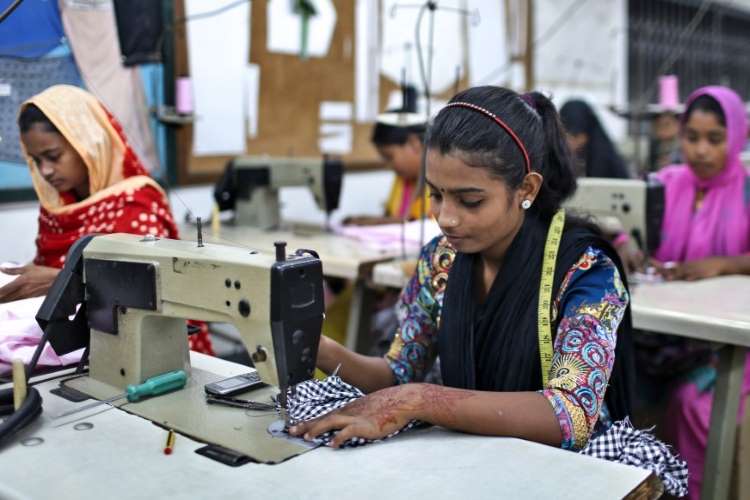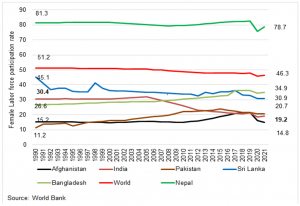
One of the biggest impediments to India achieving its huge economic potential is the low workforce participation of women compared with other major economies. (Figure – 1). The persistent decline in female labour force participation in India since 2005 is a serious cause of concern. According to World Bank data for 2021, India’s FLPR declined below the rates of its neighbours Pakistan and Bangladesh.
In the last three decades, India’s economic growth has been robust, fertility rates have fallen, and women’s enrolment in educational institutions has improved. Still, female LFPR stagnated at about 20-22%. Some of the reasons for the low female LFPR are gender bias in vocational skills, burden of childcare, lack of equal opportunities for entrepreneurship due to unequal access to finance and ownership of assets, and violence against women. The nature of economic growth in India over the last three decades also was not conducive for improving female labour force participation.
READ I The Great Indian House Trap: Burden of household work and labour force participation

Most of India’s economic growth was led by urban-focused skill-intensive sectors such as information technology (IT). Most of these skill-intensive jobs in metropolitan cities were captured by men as they remained more skilled and more educated compared with their female counterparts. Also, owing to various socio-cultural restraints, women face more difficulty in their mobility from rural to urban areas to take these jobs compared to men. Sectors like handicrafts, textiles, healthcare, and education in which women are more likely to work did not register high growth rates.
Female labour force participation in South Asia
Unlike India, Bangladesh witnessed a major jump in the participation of women in the labour market owing to the growth of the ready-made garment sector and an increase in rural employment. In simple words, not many jobs were created in those sectors that could absorb women in India. Furthermore, the mechanisation of agriculture and moving away of the workplace from home also led to a further decline in female LFPR. Rural India has witnessed a fall in female LFPR from 57% percent to 44% between 1987 and 2011.
Mechanisation reduced the need and the number of women on farms in rural areas. Migration of women to urban areas (where opportunities for jobs exist) is difficult in India due to several socio-economic and cultural constraints like inadequate childcare facilities, high housing and living costs, and insecure public transport.
The income effect of the increased household earnings is also one of the other reasons for the decline in female LFPR over time. As per MoSPI data, per-capita income in 2022 grew by 259.2% from 1991. Therefore, the women who could afford not to work owing to their improved household affluence simply dropped out of the labour market.
READ I Judiciary vs executive: Tussle over the basic structure may spill over
From the ramparts of the Red Fort, Prime Minister Narendra Modi also talked of Naari Shakti and empowerment of women. High female labour force participation is one of the most important determinants of women’s empowerment and their status in the household and society. High LFPR has many social benefits also. A higher rate of female LFPR and the consequent greater bargaining power for women is found to be associated with an increased share of nutrition, health, and education in household expenditure and reduced cases of domestic violence and sex-selective abortions.
High female LFPR also helps in improving overall productivity and economic growth. The IMF predicts that equal participation of women in the economy can add an average of 16% to the GDP of all countries, while gender parity in employment in India can boost its GDP by 27%. The talent of some of the bright women is simply getting wasted due to their low participation in labour market. Higher participation of women in labour force would lead to optimum utilisation of talent available to employers and thereby would lead to higher aggregate productivity.
High female LFPR would also promote greater diversity at the workplace which will lead to diverse perspectives, the complementarity of thought, and a more robust critical evaluation leading to better decision making and improved productivity. It is also observed that men and women have different (and often complementing) preferences towards risk-taking in banking sector and this attitude of greater caution by women has economic benefits: it balances the overall risk portfolios in the banks.
How can a country record high growth and progress when women, many educated, cannot contribute to its output? The Union and state governments need to prepare an effective strategy so that India can reap the benefits of the untapped potential of its women.
A comprehensive approach is required to increase female labour force participation through plugging the gaps in unequal access to education and skilling, provision of safe transportation and workplaces, facilitating work-life balance promoting female entrepreneurship, and providing affordable childcare on the one hand and promoting a pattern of growth that creates job opportunities for females on the other hand. A strategy would strengthen female-dominated sectors like teaching, nursing, hospitality, and textiles since they are able to better manage their family duties.
It is crucial to ensure greater mobility of women from rural to urban areas. Currently, there exist very few options to engage in paid work in villages. And the lack of affordable and high-frequency transportation restricts the mobility of many Indian women who are already time-poor because of the disproportionate burden of household chores from accessing jobs which are in cities. Investing in urban design that maximises women’s mobility will be a key component of improving female LFPR.
A strong investment push towards infrastructure promoting last-mile connectivity, safe streets, toilets for women, functional helplines, and hostels for working women can play a role in promoting access to paid work. Building affordable working women’s hostels in cities can help ease the entry and retention of women in the labour market. Also, there is also a need to incentivise firms and companies to promote a culture of more flexible work hours at their workplaces and facilitate institutionalized child-care facilities.
It is important to strengthen the care economy by increasing public and private investment in care infrastructure to make it affordable. A separate care council should be created for formalising the care work for children and the elderly. Creating a caring council for promoting a skilled workforce for the care economy by standardisation of qualification packs and certification bodies will relieve women of their care burden as they will be assured of good quality service being available to take care of their children and elderly at home.
The government should ensure better skilling of women. In the informal sector, there exists a huge bias against women when it comes to apprenticeship and imparting vocational skills. As per NFHS 5, there exists a huge digital gender divide. More tech-based skilling definitely needs to be provided to women to take advantage of the emerging gig-and platform-based economy.
The government’s flagship scheme ‘skill India’ is indeed a step in the right direction but the government could consider zero-fee structure and flexible training delivery mechanisms, for instance, afternoon batches to encourage more women in all skilling centres.
The government should also consider meeting its gender quotas to ensure female enrolment in the high-demand, high-wage technology-intensive sectors. Further, availability of appropriate scholarships and placement opportunities may be ensured for young women to enable smooth transitions to employment.
Also, the government needs to further scale up the programs for promoting women entrepreneurship. In this respect, leveraging self-help groups can also play a big role in helping budding female entrepreneurs turn their ideas into business models by linking them with the market and banks, providing them with entrepreneurial training and mentorship.
(Monika Mangala is an Indian Economic Service officer of 2020 batch. She is posted as Assistant Director, NITI Aayog.)
Dr Charan Sigh is a Delhi-based economist. He is the chief executive of EGROW Foundation, a Noida-based think tank, and former Non Executive Chairman of Punjab & Sind Bank. He has served as RBI Chair professor at the Indian Institute of Management, Bangalore.

